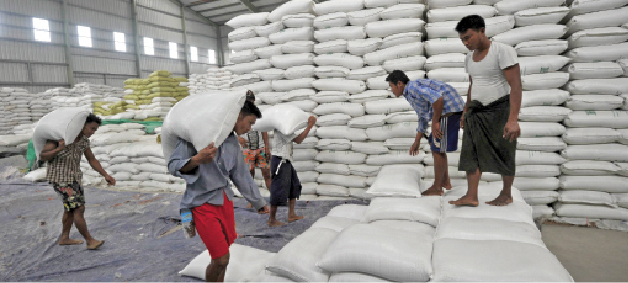June 15
The Myanmar Rice Wholesale Centre (Wahdan) reported a significant surge in the price of high-grade Shwebo Pawsan rice, with an increase of K7,000 per bag within a span of two weeks. On 1 June, the price of Shwebo Pawsan rice stood at K105,000 per bag, but by 14 June, it had soared to K112,000 per bag. The soaring cost of Shwebo Pawsan paddy, which exceeded K3 million per 100 baskets, is a key contributing factor to the elevated price of Shwebo Pawsan rice. Likewise, the prices of other rice varieties have also experienced an upward trend. The cost of old Pawsan rice ranged from K87,000 to K95,000 per bag, depending on the producing areas (Myaungmya, Pathein, Pyapon, Dedaye, and other regions). The prices of Khunni, Ngasein, short-matured rice (90-day), Emahta, Pawkywe, intercropped rice, and new Pawsan rice variety were recorded at K80,000, K58,000, K74,000, K62,500, K80,000, K63,000, and K88,000 per bag, respectively, as per the data released by Myanmar Rice Wholesale Centre (Wahdan). The prices of locally consumed rice varieties continue to rise steadily. The Myanmar Rice Federation (MRF) is committed to stabilizing the rice market and ensuring fair prices and quality products. The MRF will collaborate with rice millers, traders, and companies, urging them to strike a balance between short-term and long-term trading benefits, as stated in the MRF’s notification dated 24 April. Individuals and family entities can approach rice wholesale centres to obtain fair prices and quality products. In case of any difficulties, they can contact the MRF office, as per the provided statement. Furthermore, the MRF has encouraged the reporting of manipulators who spread malicious rumours on digital platforms to manipulate consumer concerns and raise rice prices. Such reports aim to protect the long-term interests of the rice industry, and the MRF will take appropriate action by forwarding the information to the relevant authorities if persuasion fails. It emphasizes the need for collaborative efforts from all stakeholders in the supply chain. — NN/EM



